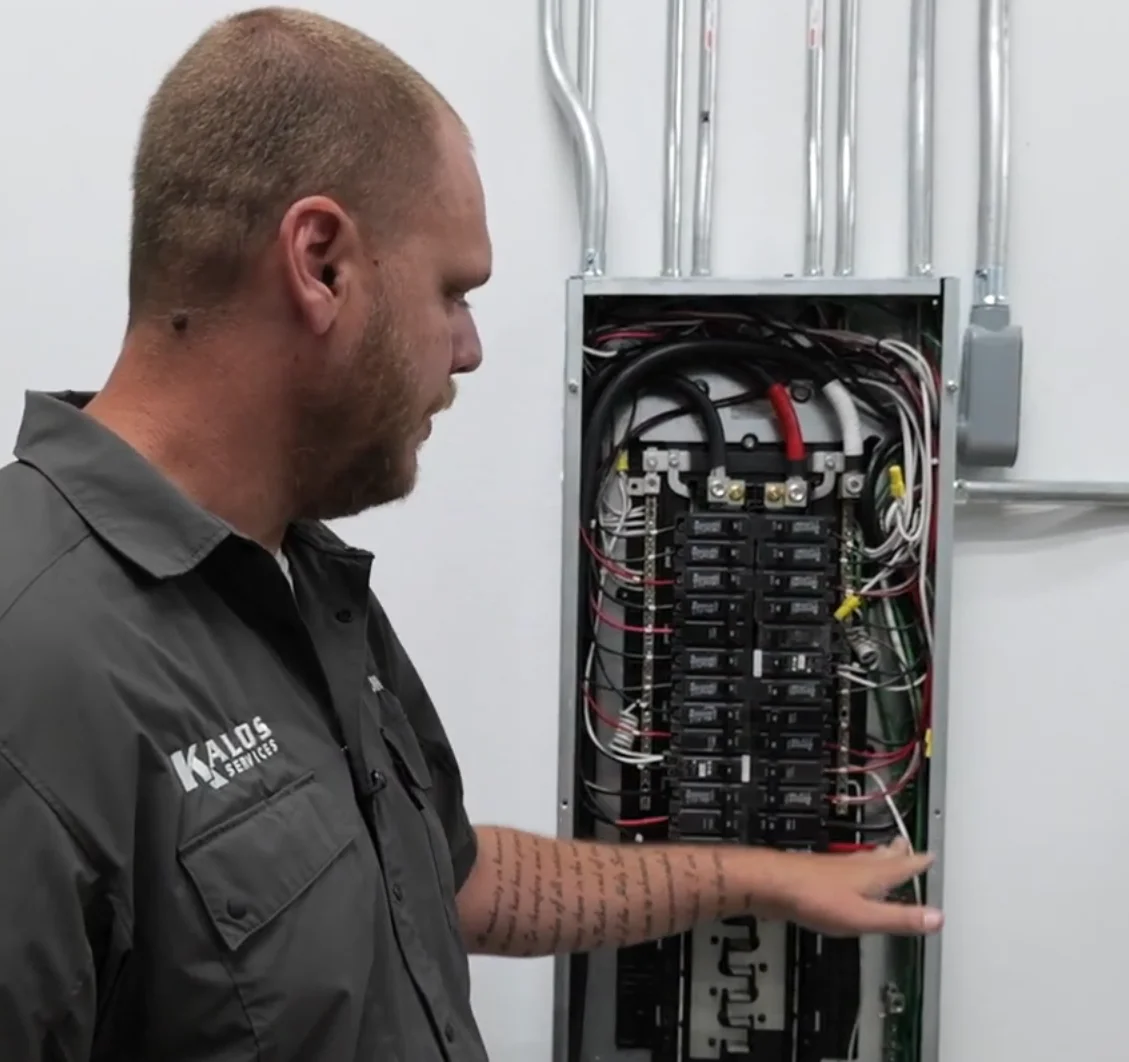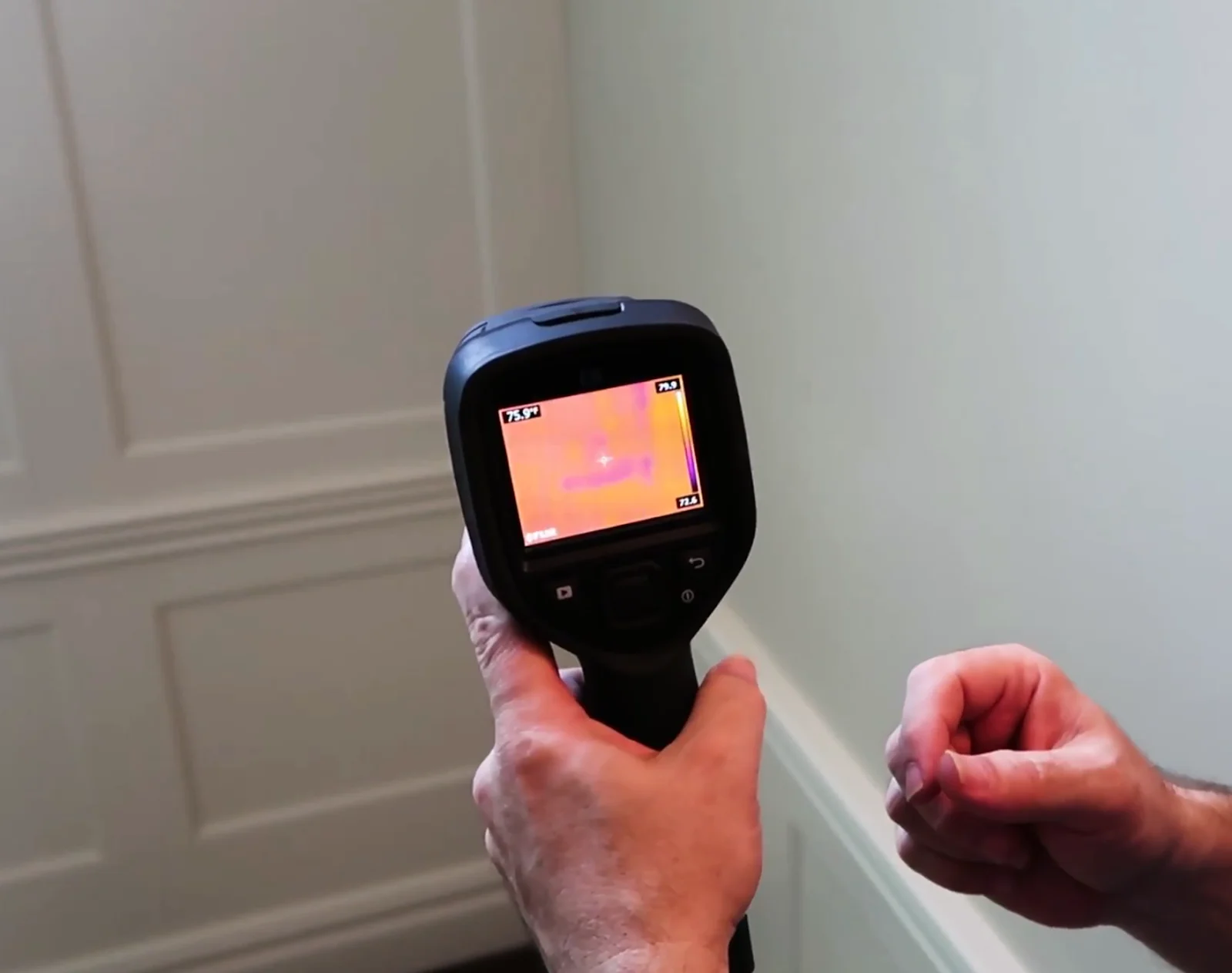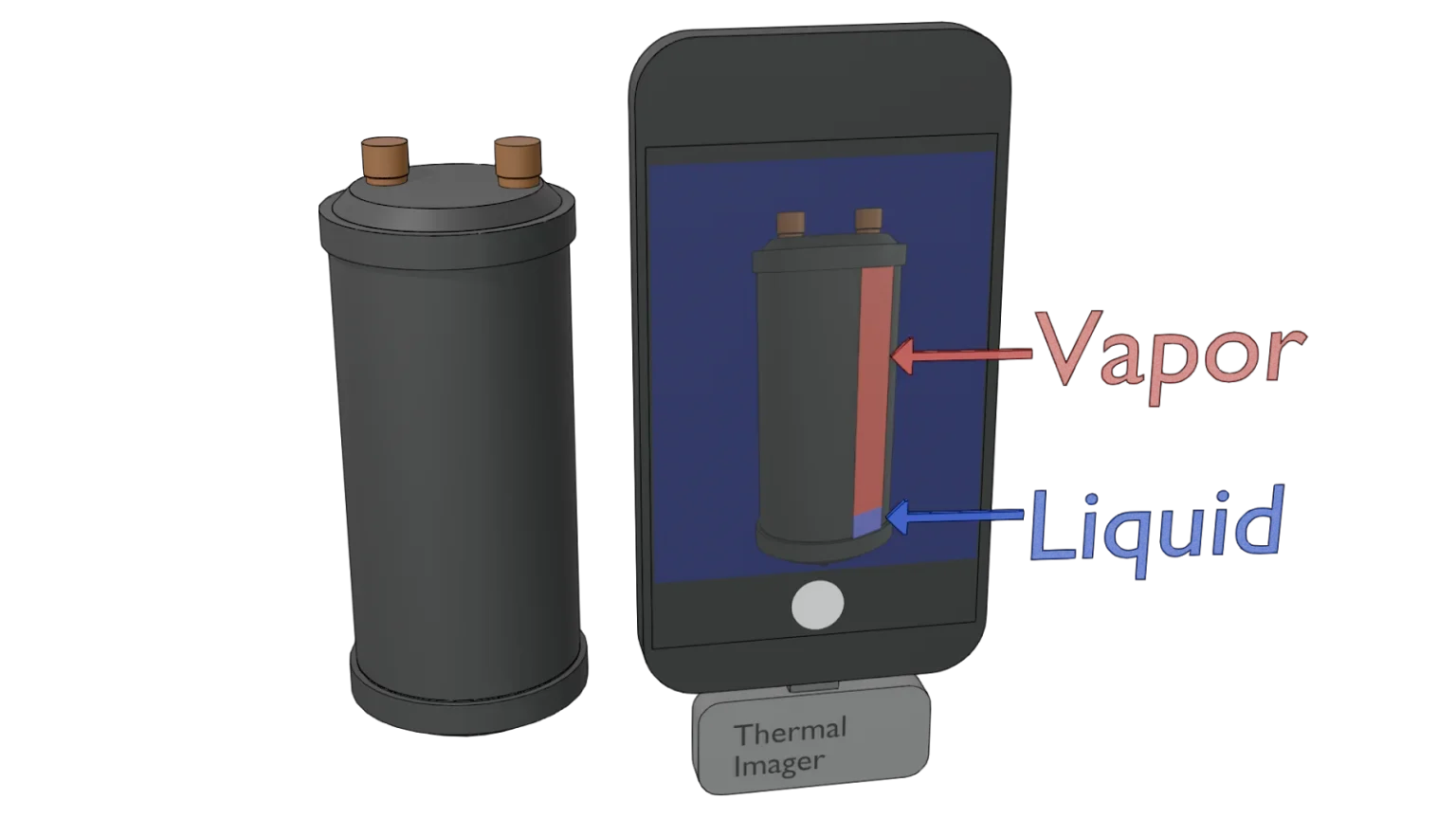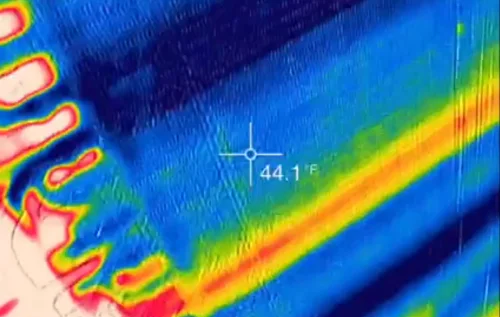Get Tech Tips
Subscribe to free tech tips.
The Many Uses of Thermal Imaging Cameras in HVAC
When most of us think about tools of the trade, a few main ones come to mind: manifold, multimeter, vacuum pumps, recovery machines… the list goes on. One that may NOT come up nearly as often as it probably should is the thermal imaging camera.
A few symposiums ago, Bill Spohn and Eric “Elk” Kaiser gave an excellent talk about thermal imaging. In that session, they covered basic thermal imaging principles and best practices, as well as some unexpected scenarios where they come in handy. We’ve been using thermal imaging cameras more at Kalos, and I’d like to share how they’ve come in handy at our business.
A Quick Note About Thermal Imaging
Thermal imaging is an excellent tool, but it comes with some caveats.
The first is that it isn’t the most reliable tool for quantitative measurements. Quantitative measurements are hard numbers—reading 241.1 volts on a multimeter, reading 3 Pascals of pressure, etc. Yes, you can interpret temperatures from the colors you see based on the level and span, but that’s not the most accurate way to sample temperatures.
Thermal imagers are much better for qualitative comparisons. If you can point it at a surface and capture a spot that looks hotter or colder than the areas around it, that’s a clue to investigate something further. It’s that same general idea of “one of these things is not like the others.” It’s still data, and it’s useful data, especially if it means saving a customer’s HVAC system (or even their life). That said, thermal imaging is most effective when you have high temperature swings (such as during the summer and winter), as those comparisons will really pop.
You also have to be aware of reflecting heat signatures. If you’re aiming your camera at a surface, and there’s another thing nearby giving off its heat, the thermal imager might capture the reflection from the nearby object, not the subject of the thermal image itself. Pay attention to the emissivity of the surfaces you’re measuring and those nearby. If you need to cover up a nearby heat signature, a trash bag is a surprisingly effective way to block the heat emitted by other nearby objects… maybe just don’t apply that logic to people and animals.
With that out of the way, let’s get into the way we use thermal imagers at Kalos.
Electrical Safety Inspections
While I was maybe exaggerating a little about saving a customer’s life, that’s actually not so far-fetched when we’re talking about electrical connections.
Within the last two years, Kalos has added residential plumbing and electrical services, and this year, we’ve created an all-inclusive maintenance plan. As part of that, we’ve trained our HVAC technicians to use thermal cameras in electrical panels and in places like the attic.

Loose wiring connections can get very hot. If flammable materials are nearby, then that could quickly become a disaster. Our team members use thermal imagers to look for irregularities in breaker panels, attics, and junction boxes to look for exceptionally hot areas. In the panel specifically, it’s critical to check the main lines AND each individual breaker for hot spots, as those usually indicate a loose connection. The heat will only show up if the circuit has power, and it’s unrealistic to turn every light or appliance on, so we need to do a little discovery and ask if customers have noticed anything odd with their electrical system, such as lights dimming. Then, we can check those individual circuits with a thermal imager.
And even if you’re not offering basic electrical inspections as a service, you can use your thermal camera to check tripping breakers. Breakers often trip when there is simply a loose connection, and a thermal camera will show unusual heat where those loose connections are.
Keep in mind that AFCI breakers tend to run a little warmer than normal breakers, and this will be apparent on a thermal image. That’s normal, and there’s only really an issue if one AFCI looks significantly warmer than the others.
Checking for Hot Spots During Operation
Just as you can use differences in temperature to find hot spots in electrical panels, you can use thermal imagers on the actual HVAC equipment.
Thermal imagers will work best when you can use them comparatively, such as in commercial refrigeration, when you have a rack with multiple compressors or a condenser with multiple fans. You can see which compressors and fans are running relatively hot compared to the others. Excessive heat could indicate bearing lubrication issues; in a compressor, that could be a result of liquid refrigerant ejecting oil.
You can also look for belt alignment issues. A belt that’s rubbing against the sheave or pulley generates friction, which generates heat. You can capture this heat with a thermal imager to see precisely where and how the misalignment occurred.
Moreover, if you want to touch something that might be hot, use a thermal imager to see just how hot it might be compared to the area around it. You could spare yourself some burnt fingies.
Getting an Idea of Building Characteristics
When it comes to comfort, the actual HVAC system is only part of the picture. It can’t succeed if the house is leaky or lacks insulation. While some gaps in the building envelope hide in plain sight, and we can easily see when attics don’t have very much insulation, a thermal camera makes it a lot easier to identify problem areas.
Thermal bridging happens when the framing of a building consists of highly conductive building materials, like metal studs. When it’s hot outside, heat will conduct into the structure via those studs; they’ll glow pretty bright on a thermal imager. When it’s cold, they’ll look darker than the insulated areas that hold onto heat better. You can see where highly conductive studs are and where the home might be lacking insulation. While most HVAC contractors don’t work on insulation in walls, they can still share their findings and possibly even refer a customer to an insulation specialist they trust.
We can also identify air leakage pathways. Vents and boots are often not properly sealed to the ceiling. The same goes for recessed can lights. These openings allow attic air to seep inside the living space, bringing dust and humidity with it. Depending on the season, the vent will be either warmer (heating season) or cooler (cooling season) than the surrounding ceiling temperature. The edges should be the same as the rest of the ceiling. If there are fuzzy plumes of hot or cold around the vent, you’ll know there’s a leakage problem.
Air leaks are amplified when you bring a blower door into the picture. Depressurizing the house to -20 Pa will make it a lot easier to see light or dark plumes near air leaks on the thermal imaging camera.

Assessing Liquid Levels In a Sealed Container
I won’t go too deep into this one since JD Kelly wrote a tech tip about the entire process, but you can use thermal imagers to check how much liquid is in an accumulator, a receiver, or even a refrigerant tank.

Inside any one of these tanks, you’ll have liquid on the bottom and vapor on the top. Liquid and vapor respond differently to heat, so you can use a heat gun on a vertical section of the tank to heat the vapor and liquid unevenly. Then, when you take a picture with a thermal camera, there will be a very clear line between the warmer vapor and cooler liquid.
Finding Restrictions
Using a similar principle, we can use the thermal imager to find a clear point where the temperature drops in refrigerant lines.
We often use temperature clamps to measure temperature differences across filter-driers to determine if they’re clogged and need to be replaced. With a thermal imager, you may not get precise temperature values, but you can see where a bright glow fades to a dimmer color. You could take a picture of the entire indoor and outdoor units and visible piping to get a full picture of the system. Using this process, you could find restrictions in the discharge line, identify restrictions within the coils, and notice feeding issues.

Credit: Ulises Palacios
The only thing to note is that temperature drops on suction lines, such as if you have a kink in the suction line, are usually rather low.
Visualizing Condenser Stacking and Subcooling
A thermal imager can be a great way to see the three different phases of refrigerant in a condenser. The condenser accomplishes three things: desuperheating, condensing, and subcooling.
The top segment takes in very hot discharge gas and quickly begins rejecting heat from it. Once the vapor has reached the saturation temperature, the middle section of the condenser will stay at one temperature. Remember: when a substance is at saturation, all BTUs in or out go towards a phase change, not a temperature change. Then, once the refrigerant is 100% liquid, the temperature will drop, which is the subcooling stage.
You can take a thermal imager and see where those three stages start and end. On a diagnostic note, seeing too much subcooled liquid will let you know of a possible restriction or overcharge condition (coupled with higher head pressure and compression ratio).
While you absolutely should NOT use a thermal camera to get accurate temperature measurements, it’s a great visual tool for HVAC veterans as well as new apprentices and non-professionals alike.
Customers may not understand numeric readings (i.e., what’s fine and what’s too high or low), but they can see a hot or cold spot and immediately know that something isn’t right. It’s also great for people who are new to the trade and learning about heat transfer, how certain components work, and more. We even use thermal imagers in GRIT camps where tradespeople mentor middle and high schoolers as they learn trade skills.

All in all, thermal imagers are extremely versatile and make great diagnostic and learning tools. Plus, they’re really cool. I highly recommend getting one and learning how to use it; it can really help your customers visualize the issues with their home or HVAC system and feel more comfortable with your recommendations and solutions.











Comments
To leave a comment, you need to log in.
Log In